Feeling Machine for Process Monitoring of Turning Hybrid Solid Components
Abstract
1. Introduction
2. Materials and Methods
2.1. Materials
2.2. Machining and Data Acquisition
2.3. Simulation of Process Errors
2.4. Monitoring
3. Results and Discussion
3.1. Tool Breakage
3.2. Tool Wear
3.3. Material Detection
4. Conclusions
Author Contributions
Funding
Conflicts of Interest
References
- Tönshoff, H.K.; Wulfsberg, J.P.; Jals, H.J.J.; König, W.; Van Luttervelt, C.A. Developments and Trends in Monitoring and Control of Machining Processes. CIRP Ann. 1988, 37, 611–622. [Google Scholar] [CrossRef]
- Rehorn, A.G.; Jiang, J.; Orban, P.E. State-of-the-art methods and results in tool condition monitoring: A review. Int. J. Adv. Manuf. Technol. 2005, 26, 693–710. [Google Scholar] [CrossRef]
- Behrens, B.A.; Chugreev, A.; Selinski, M.; Matthias, T. Joining zone shape optimisation for hybrid components made of aluminium-steel by geometrically adapted joining surfaces in the friction welding process. In AIP Conference Proceedings, Proceedings of the 18th International Conference on Positron Annihilation, Vitoria-Gasteiz, Spain, 8–10 May 2019; AIP Publishing: Melville, NY, USA, 2019. [Google Scholar] [CrossRef]
- Behrens, B.A.; Chugreeva, A.; Mildebrath, M.; Diefenbach, J.; Barroi, A.; Lammers, M.; Hermsdorf, J.; Hassel, T.; Overmeyer, L. Manufacturing of High-Performance Bi-Metal Bevel Gears by Combined Deposition Welding and Forging. Metals 2018, 8, 898. [Google Scholar] [CrossRef]
- Abellan-Nebot, J.V.; Subirón, F.R. A review of machining monitoring systems based on artificial intelligence process models. Int. J. Adv. Manuf. 2010, 47, 237–257. [Google Scholar] [CrossRef]
- Teti, R. Advanced IT Methods of Signal Processing and Decision Making for Zero Defect Manufacturing in Machining. Procedia CIRP 2015, 28, 3–15. [Google Scholar] [CrossRef]
- Siddhpura, A.; Paurobally, R. A review of flank wear prediction methods for tool condition monitoring in a turning process. Int. J. Adv. Manuf. 2013, 65, 371–393. [Google Scholar] [CrossRef]
- Lauro, C.H.; Brandão, L.C.; Baldo, D.; Reis, R.A.; Davim, J.P. Monitoring and processing signal applied in machining processes—A review. Measurement 2014, 58, 73–86. [Google Scholar] [CrossRef]
- Balsamo, V.; Caggiano, A.; Jemielniak, K.; Kossakowska, J.; Nejman, M.; Teti, R. Multi Sensor Signal Processing for Catastrophic Tool Failure Detection in Turning. Procedia CIRP 2016, 41, 939–944. [Google Scholar] [CrossRef]
- Sun, J.; San, W.Y.; Soon, H.G.; Rahman, M.; Zhigang, W. Identification of Feature Set for Effective Tool Condition Monitoring-A Case Study in Titanium Machining. In Proceedings of the IEEE Conference on Automation Science and Engineering, Arlington, VA, USA, 23–26 August 2008; IEEE Xplore: Washington, DC, USA; pp. 273–278. [Google Scholar] [CrossRef]
- Caggiano, A. Cloud-based manufacturing process monitoring for smart diagnosis services. Int. J. Comput. Integr. Manuf. 2018, 31, 612–623. [Google Scholar] [CrossRef]
- Altintas, Y. Prediction of cutting forces and tool breakage in milling from feed drive current measurement. J. Manuf. Sci. Eng. 1992, 114, 386–392. [Google Scholar] [CrossRef]
- Aslan, D.; Altintas, Y. Prediction of cutting forces in five-axis milling using feed drive current measurements. IEEE/ASME Trans. Mechatron. 2018, 23, 833–844. [Google Scholar] [CrossRef]
- Möhring, H.C.; Nguyen, Q.P.; Kuhlmann, A.; Lerez, C.; Nguyen, L.T.; Misch, S. Intelligent tools for predictive process control. Procedia CIRP 2016, 57, 539–544. [Google Scholar] [CrossRef]
- Brecher, C.; Eckel, H.M.; Motschke, T.; Fey, M.; Epple, A. Estimation of the virtual workpiece quality by the use of a spindle-integrated process force measurement. Ann. CIRP 2019, 68, 381–384. [Google Scholar] [CrossRef]
- Teti, R.; Jemielniak, K.; Odonnell, G.; Dornfeld, D. Advanced Monitoring of Machining Operations. Ann. CIRP 2010, 59, 717–739. [Google Scholar] [CrossRef]
- Altintas, Y.; Kersting, P.; Biermann, D.; Budak, E.; Denkena, B.; Lazoglu, I. Virtual process systems for part machining operations. Ann. CIRP 2014, 63, 585–605. [Google Scholar] [CrossRef]
- Denkena, B.; Boujnah, H. Feeling machines for online detection and compensation of tool deflection in milling. Ann. CIRP 2018, 67, 423–426. [Google Scholar] [CrossRef]
- Denkena, B.; Dahlmann, D.; Kiesner, J. Production Monitoring Based on Sensing Clamping Elements. Procedia Technol. 2016, 26, 235–244. [Google Scholar] [CrossRef]
- Denkena, B.; Park, J.K.; Bergmann, B.; Schreiber, P. Force sensing linear rolling guides. In Proceedings of the Euspen’s 18th International Conference & Exhibition, Venice, Italy, 4–8 June 2018. [Google Scholar]
- Bergmann, B.; Witt, M. Feeling machine for material-specific machining. Ann. CIRP 2020, 69. [Google Scholar] [CrossRef]
- Kienzle, O. Die Bestimmung von Kräften und Leistungen an spanenden Werkzeugmaschinen. Zeitschrift des Vereines Deutscher Ingenieure 1952, 94, 299–305. [Google Scholar]
- Tlusty, J.; Andrews, G.C. A Critical Review of Sensors for Unmanned Machining. Ann. CIRP 1983, 32, 563–572. [Google Scholar] [CrossRef]
- Brinkhaus, J.W. Statistische Verfahren zur selbstlernenden Überwachung spanender Bearbeitungen in Werkzeugmaschinen: (Statistical Methods for Self-Teaching Monitoring of Machining Operations in Machine Tools). Ph.D. Thesis, Leibniz University, Hannover, Germany, 18 December 2008. [Google Scholar]
- Denkena, B.; Bergmann, B.; Witt, M. Automatic process parameter adaption for a hybrid workpiece during cylindrical operation. Int. J. Adv. Manuf. Technol. 2017, 95, 311–316. [Google Scholar] [CrossRef]
- Denkena, B.; Dahlmann, D.; Damm, J. Self-adjusting process monitoring system in series production. Procedia CIRP 2015, 33, 233–238. [Google Scholar] [CrossRef]
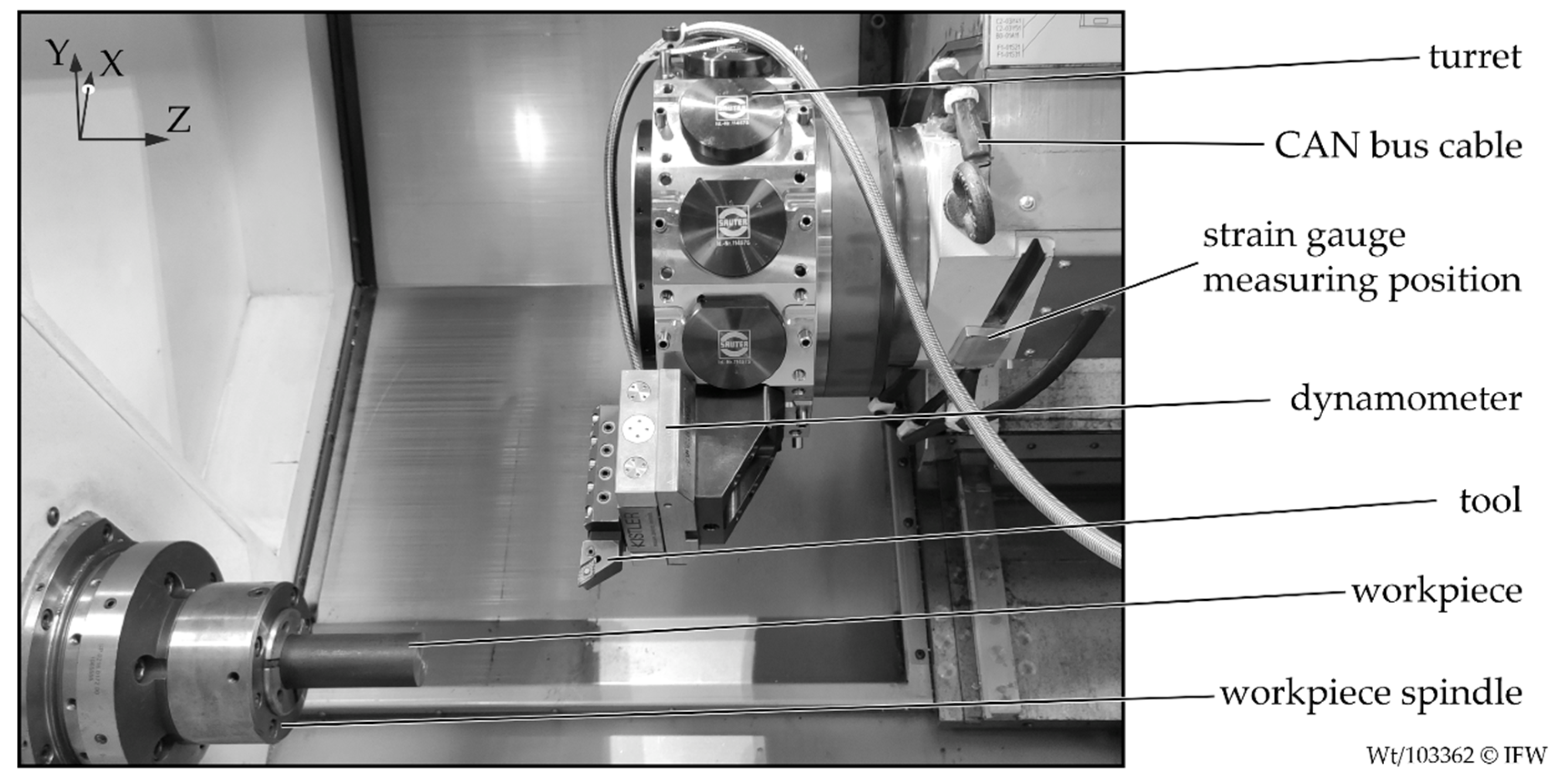
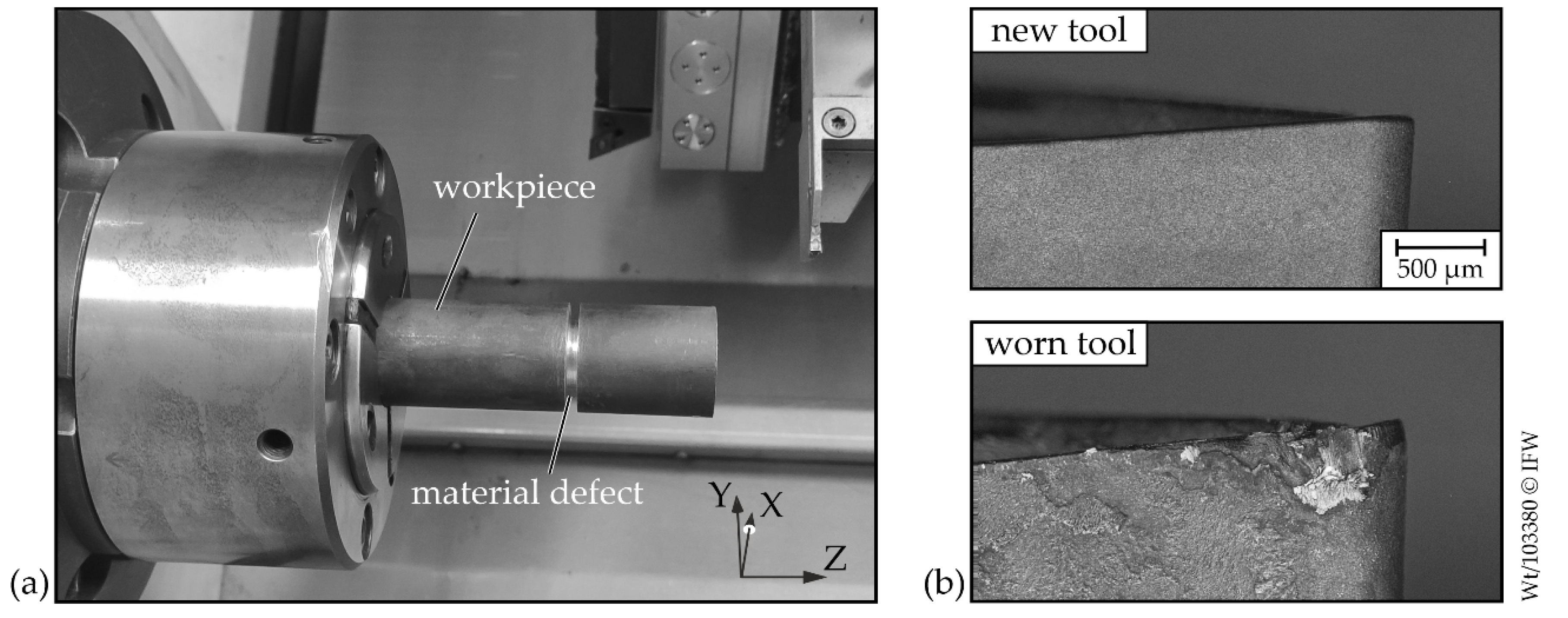
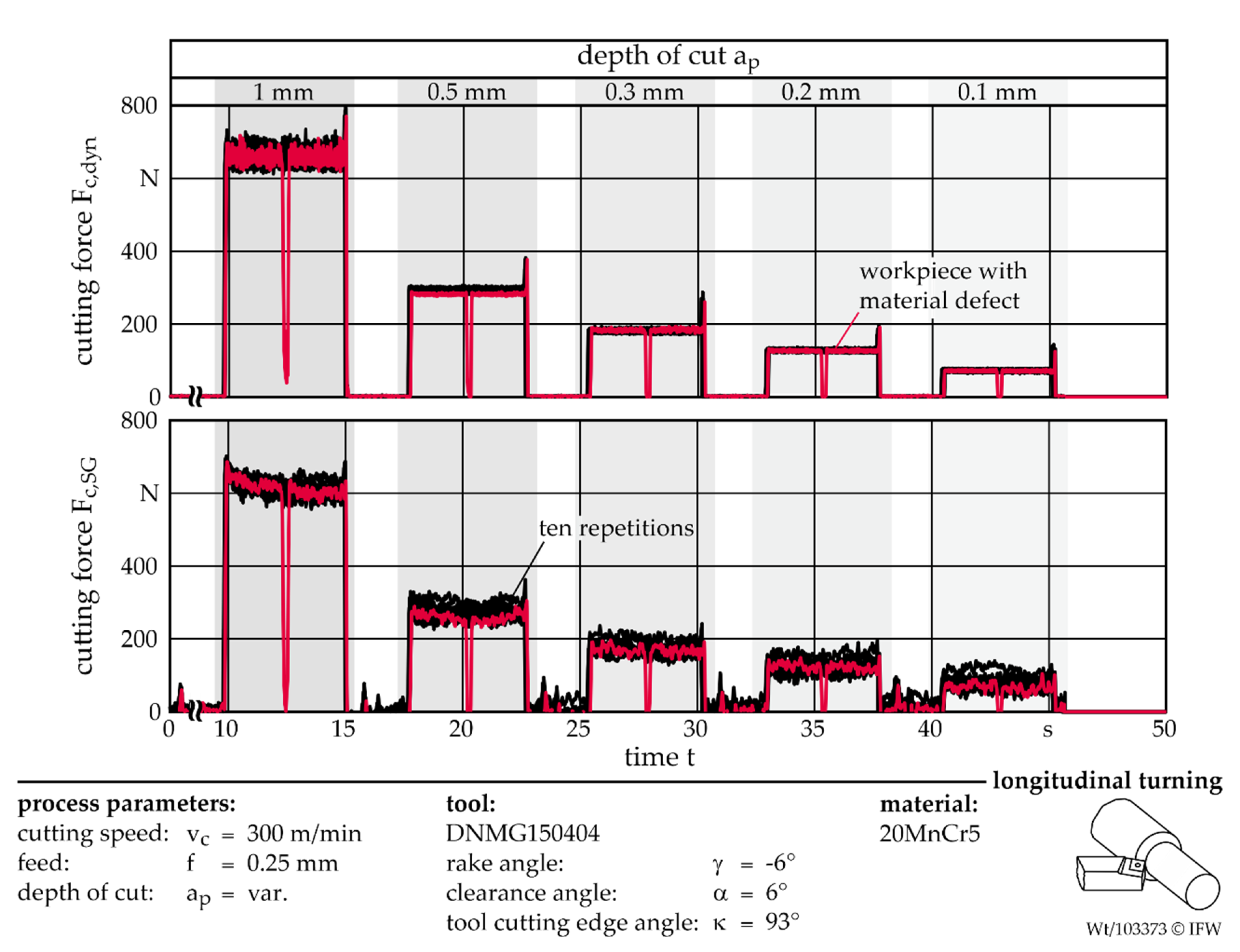
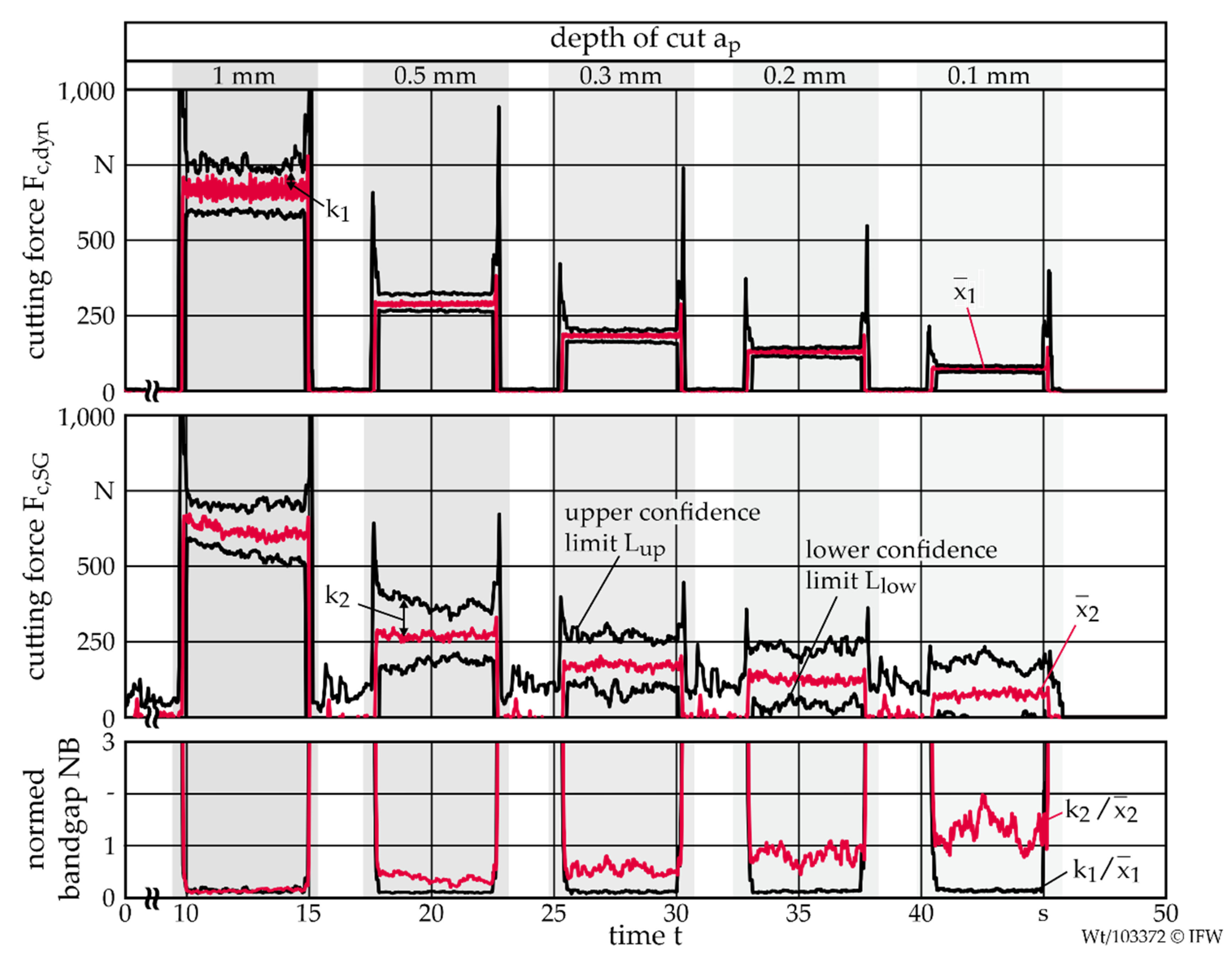

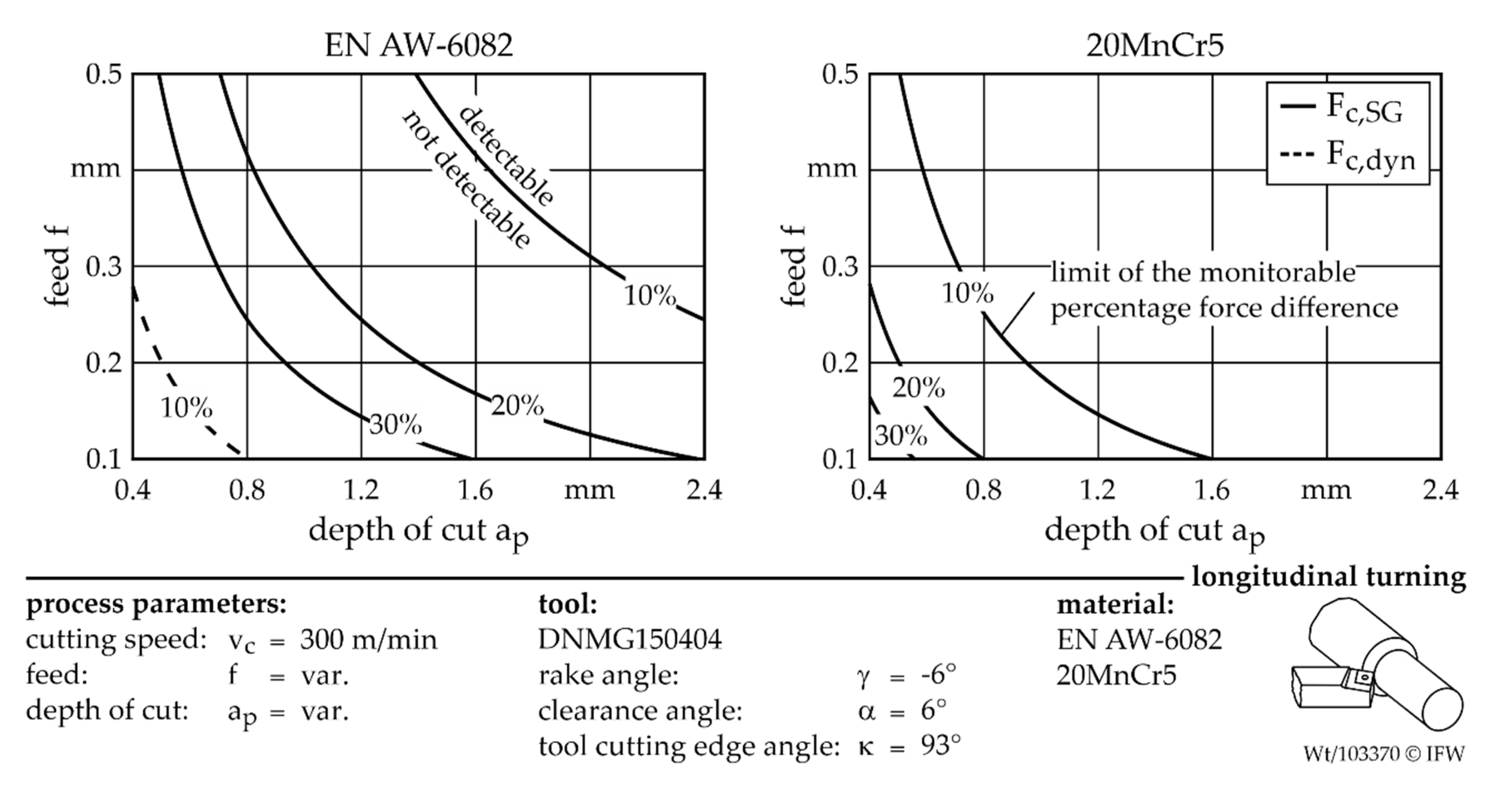
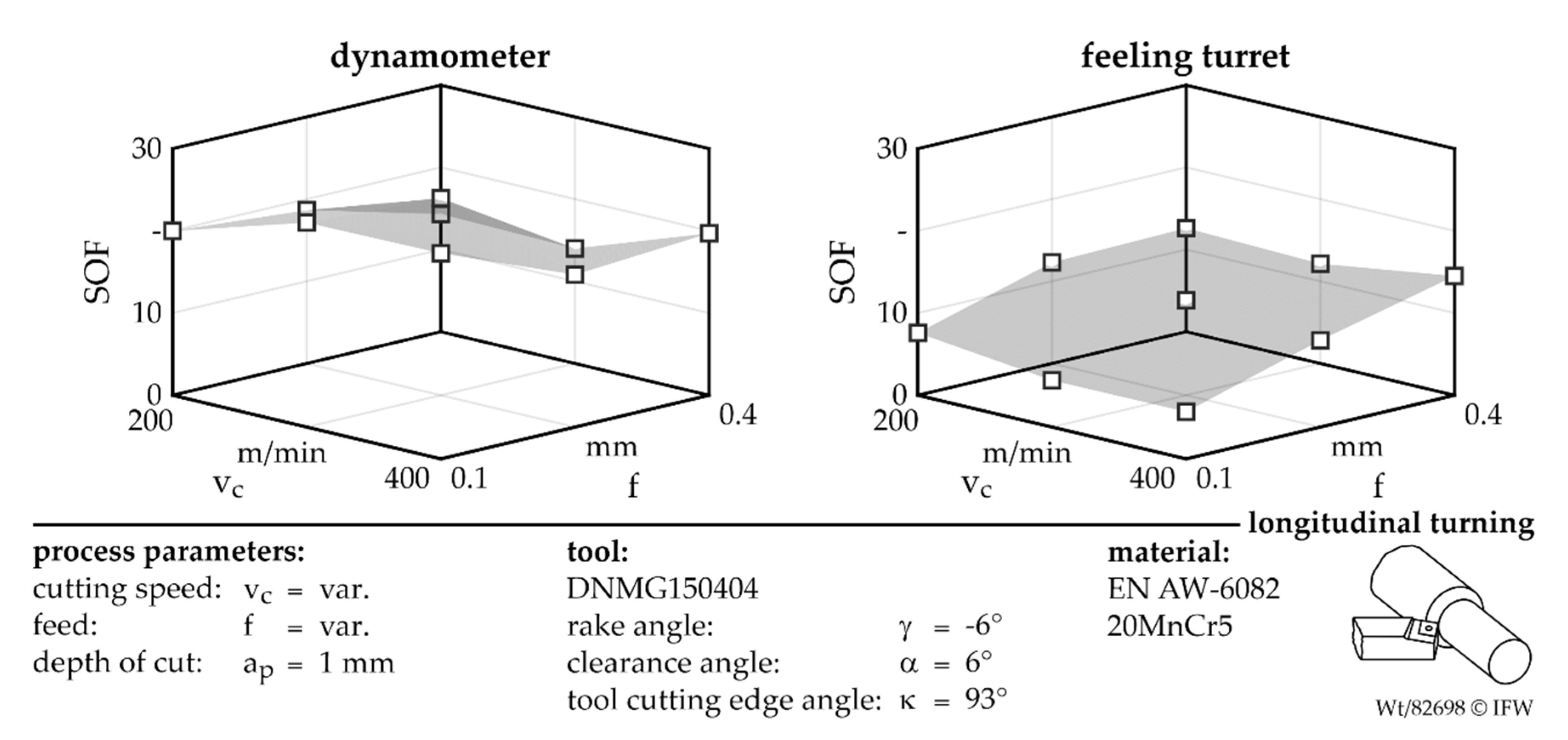
| Material Properties | EN AW-6082 | 20MnCr5 |
|---|---|---|
| density [g/cm3] | 2.70 | 7.75 |
| hardness [HV] | 100 | 268 |
| ultimate tensile strength [MPa] | 310 | 980–1280 |
| Young’s modulus [GPa] | 70 | 210 |
| thermal expansion coefficient [10−6K−1] | 23.4 | 11.5 |
| thermal conductivity [W/mK] | 170–220 | 42 |
| Parameter | Symbol | Material | |
|---|---|---|---|
| 20MnCr5 | EN AW-6082 | ||
| specific cutting force | kc1.1 | 2140 N/mm2 | 742 N/mm2 |
| material exponent | mc | 0.250 | 0.236 |
| Signal-to-Noise Ratio (SNR) | Depth of Cut ap [mm] | ||||
|---|---|---|---|---|---|
| 1 | 0.5 | 0.3 | 0.2 | 0.1 | |
| cutting force by dynamometer Fc,dyn | 46 | 149 | 78 | 90 | 70 |
| cutting force by feeling turret Fc,SG | 40 | 26 | 16 | 12 | 7 |
© 2020 by the authors. Licensee MDPI, Basel, Switzerland. This article is an open access article distributed under the terms and conditions of the Creative Commons Attribution (CC BY) license (http://creativecommons.org/licenses/by/4.0/).
Share and Cite
Denkena, B.; Bergmann, B.; Witt, M. Feeling Machine for Process Monitoring of Turning Hybrid Solid Components. Metals 2020, 10, 930. https://doi.org/10.3390/met10070930
Denkena B, Bergmann B, Witt M. Feeling Machine for Process Monitoring of Turning Hybrid Solid Components. Metals. 2020; 10(7):930. https://doi.org/10.3390/met10070930
Chicago/Turabian StyleDenkena, Berend, Benjamin Bergmann, and Matthias Witt. 2020. "Feeling Machine for Process Monitoring of Turning Hybrid Solid Components" Metals 10, no. 7: 930. https://doi.org/10.3390/met10070930
APA StyleDenkena, B., Bergmann, B., & Witt, M. (2020). Feeling Machine for Process Monitoring of Turning Hybrid Solid Components. Metals, 10(7), 930. https://doi.org/10.3390/met10070930





